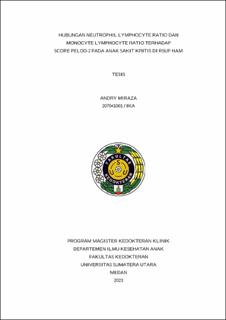| dc.description.abstract | Background: Critically ill children admitted to the pediatric intensive care unit (PICU) from 75 to 166 per 100,000 children/year including respiratory diseases, infectious diseases, congenital diseases, and perioperative care. Early detection of disease severity in critically ill children uses the PELOD-2 score. Previous studies have shown that neutrophil lymphocyte ratio (NLR) can be used as a predictor of pediatric mortality and monocyte and lymphocyte ratio (MLR) to determine the severity of Klebsiella pneumonia infection.
Objective: To determine the correlation of NLR and MLR to PELOD-2 score in critically ill children in the PICU of Haji Adam Malik General Hospital.
Methods: Cross sectional analytic research from medical records, then documentation of PELOD-2 scores. The subjects were critically ill children from October to December 2022 according to the inclusion and exclusion criteria. Data were analyzed with the Spearman correlation test.
Results: A total of 59 pediatric patients in the PICU of Haji Adam Malik General Hospital, the most was female 34 patients (57.6%). The mean age of the children was 6.23 years old. With the most indications was respiratory disease 22 people (37.3%). Spearman correlation test analysis showed that there was no significant correlation between NLR and MLR with PELOD 2 on the first day (p=0.316 and p=0.696) and MLR with PELOD 2 on the third day of treatment (p=0.077). However, a significant correlation was found between NLR and PELOD 2 in critically ill children on the third day of care (p=0.014).
Conclusion: There was a significant correlation between NLR and PELOD-2 score on the third day of care. However, there was no correlation between first and third day MLR and first day NLR with PELOD-2 score. | en_US |




